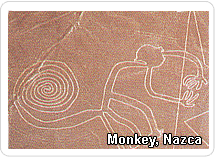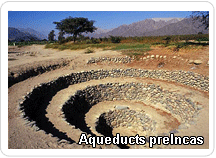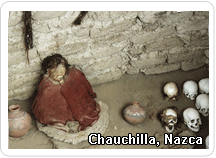
The enigmatic Nazca Lines, ancient geoglyphs etched into the desert floors of Southern Peru, have captured the imagination of historians, archaeologists, and travelers alike.
These colossal drawings, visible only from the air or nearby hilltops, span hundreds of feet across the arid plains, depicting animals, plants, and geometric shapes. The mystery surrounding their purpose — whether astronomical, ritualistic, or something entirely different — has made the Peruvian Nazca Lines a magnet for adventure seekers and culture enthusiasts from around the globe, propelling them to the forefront of Peru’s tourist attractions.
Highlights include an overview of must-see attractions such as the Cantalloc Aqueducts, Chauchilla Cemetery, and the ceremonial center of Cahuachi.

Nazca, a city in Peru’s Ica region, is strategically positioned on a coastal plain about 280 miles (450 kilometers) south of Lima. Surrounded by the desert, which is quite flat until it meets the western ridges of the Andes Mountains, Nazca serves as the gateway to the famous Nazca Lines. East of the city, Cerro Blanco rises to an elevation of 6,820 feet (2,078 meters), marking one of the world’s tallest dunes.
The climate in Nazca is characterized by high temperatures and extreme aridity, with annual precipitation around 4mm. Summers, from December to March, are hot with daytime highs reaching up to 90°F (32°C), while winter months from May to September see slightly cooler daytime highs around 80°F (27°C) and nighttime lows around 55°F (13°C). The Humboldt Current plays a crucial role in maintaining minimal rainfall and preserving the dry conditions favorable for viewing the Nazca Lines.
The optimal time to visit Nazca for warm-weather activities is from late April to mid-October, with the peak travel period in the last week of August. For those interested in hot-weather activities, the period from early November to late May is ideal, particularly in the third week of April when conditions are most favorable. These periods offer clear, rainless days with ideal temperatures for exploring the outdoors and viewing the ancient geoglyphs.
The Nazca culture, thriving from around 100 BC to 800 AD in the arid southern coast of Peru, was renowned for its sophisticated irrigation systems and the mysterious Nazca Lines. These lines, immense desert drawings visible only from above, suggest a society capable of organizing large-scale projects.
First recorded in the 1920s, the Nazca Lines have been studied extensively. Archaeologists like Toribio Mejia Xesspe first brought them to academic attention in 1939, theorizing their significance in Nazca culture. Subsequent studies have focused on their potential astronomical alignment and cultural significance.
Various theories about the purpose of the Nazca Lines range from astronomical calendars to religious pathways. The most accepted theories suggest they played a role in water worship rituals, crucial for crop fertility in such an arid region. Despite extensive research, these geoglyphs retain an aura of mystery, compelling ongoing investigation and fascination.
Nazca, Peru, offers a rich tapestry of attractions beyond the mysterious Nazca Lines. Visitors can explore the Nazca Lines Flights for an aerial view of the geoglyphs, providing a unique perspective on these ancient wonders. The Torre Mirador (Observation Tower) offers ground-based views at a height of 42 feet (13 meters), allowing for detailed observation of figures like the hands and the tree.
The Maria Reiche Museum honors the German mathematician who studied the lines extensively, displaying her tools and photographs. Cahuachi, an ancient ceremonial center of the Nazca culture, spans over 0.75 miles (1.2 kilometers) and provides insights into their religious practices.

Cantalloc Aqueducts, an engineering marvel, showcases the Nazca’s advanced water management systems. The Antonini Archaeological Museum is key for understanding local history with artifacts from the Nazca civilization.
For a cosmic experience, the Nazca Planetarium offers evening shows explaining the astronomical theories behind the lines. The Chauchilla Cemetery, with well-preserved mummies, offers a glimpse into Nazca burial practices.

Los Paredones features the ruins of an Inca administrative center, and the towering Cerro Blanco offers challenging treks and spectacular views from one of the highest sand dunes in the world. These sites collectively enrich the understanding and appreciation of Nazca’s cultural and historical significance.
For the best views of the Nazca Lines, opt for a flight, which lasts about 30 minutes. Try to get an early morning flights for less turbulence. Remember to bring anti-nausea medication if prone to motion sickness.
The Nazca Lines are mysterious due to their enormous scale, intricate designs, and the unclear purpose behind their creation. These geoglyphs, which can only be fully appreciated from the air, continue to intrigue researchers and visitors alike, leading to numerous theories about their origin and significance.
The Nazca Lines have remained remarkably well-preserved due to the dry, windless, and stable climate of the Nazca desert. The lack of erosion and minimal rainfall in the region helps maintain the visibility of these ancient geoglyphs.
The true purpose and meaning of the Nazca Lines remain one of archaeology’s great mysteries. Various theories suggest they could have been used for astronomical, religious, or agricultural purposes, but no definitive explanation has been proven.
While there have been incidents of damage due to human activity, such as unauthorized human incursions, vehicle tracks and unauthorized construction, there is no single entity that has destroyed the Nazca Lines. Efforts are ongoing to protect and preserve these historical treasures.
No, the Nazca Lines were created by the Nazca culture, not the Aztecs. The Nazca civilization thrived in southern Peru, whereas the Aztec civilization was centered in present-day Mexico.
The main threats to the Nazca Lines include human activities such as illegal encroachments, vehicle damage, and tourism-related wear and tear. Environmental changes and natural erosion also pose risks, though the arid climate helps mitigate these effects.
The meaning of specific figures, such as spiders, in the Nazca Lines is not definitively known. Some researchers suggest that these figures could have had symbolic or religious significance, possibly related to local mythology or astronomy.
While some of the Nazca Lines can be seen on Google Maps, the full scale and intricate details are best appreciated from an aerial perspective, which is why small plane flights are popular among visitors.
The specific meaning of the hummingbird figure in the Nazca Lines is not known. It is one of the many intricate designs created by the Nazca people, possibly holding symbolic or cultural significance.
The content does not detail the downfall of the Nazca civilization. However, it is believed that environmental changes, such as prolonged droughts, and resource depletion may have contributed to their decline.
The Nazca Lines have not eroded significantly due to the region’s extremely dry, windless, and stable climate. The desert conditions have helped preserve the lines for centuries.
The geoglyphs are called the Nazca Lines because they were created by the Nazca culture, which inhabited the region where the lines are located.
Common myths about the Nazca Lines include theories that they were created by extraterrestrials or served as ancient runways for alien spacecraft. While intriguing, these theories lack scientific evidence.
The mystery of the Nazca Lines lies in their grand scale, complex designs, and the unknown reasons for their creation. Despite extensive research, the exact purpose and methods used to create these geoglyphs remain subjects of speculation and debate.
The Nazca Lines are not visible from space with the naked eye. They are best viewed from aircraft flying over the region, which allows observers to fully appreciate their size and detail.
You can find lots of essential information about the Nazca Lines and nearby attractions on our Nazca Info page and book a fly-over on our Nazca Tours page.